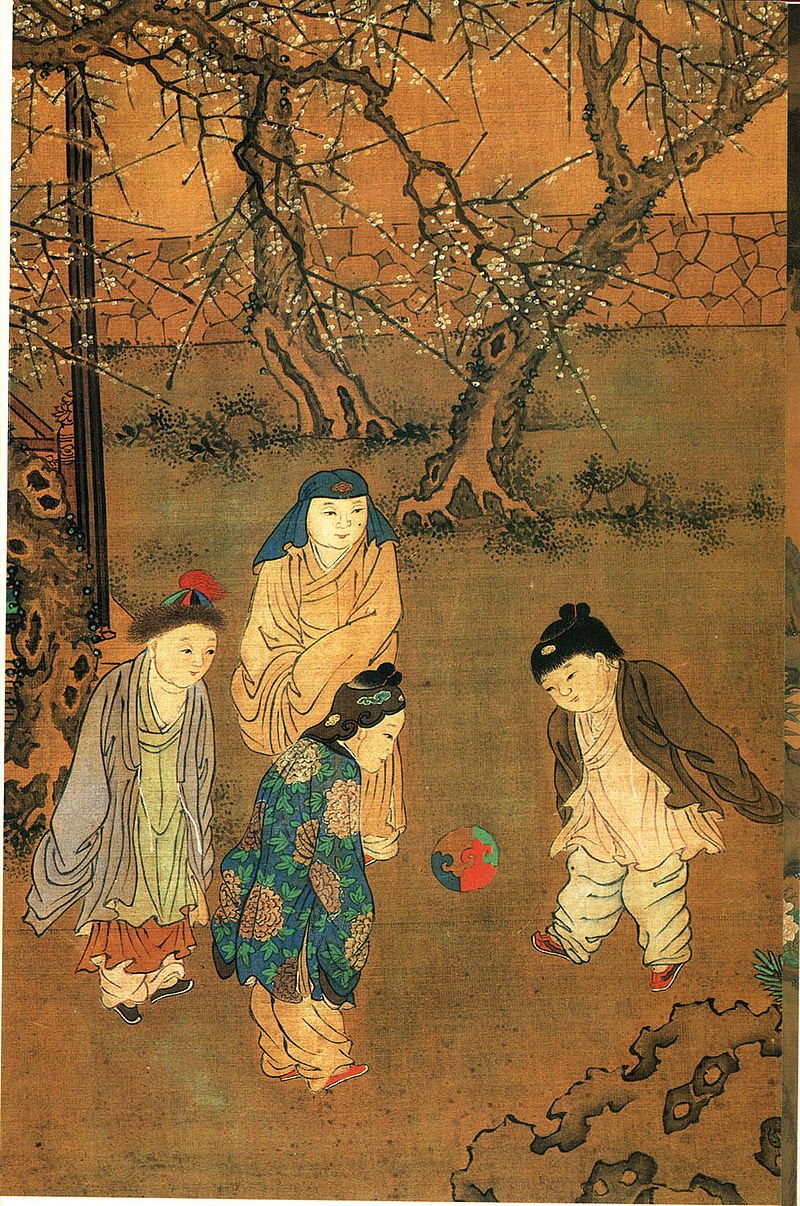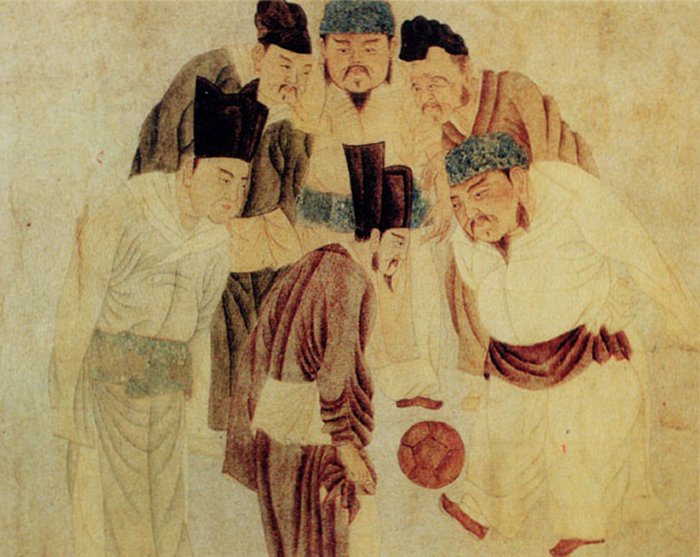Ancient Chinese Ball Game Cuju Is Earliest Form Of Football
Conny Waters - AncientPages.com - An interesting question is when and where we started playing football.
There are several references to traditional, ancient, or prehistoric ball games played by indigenous peoples in many parts of the world. The history of football stretches far back in time. According to FIFA, the competitive game cuju is the earliest form of football for which there is scientific evidence.
One Hundred Children in the Long Spring, a painting by Chinese artist Su Hanchen, active AD 1130–the 1160s), Song Dynasty. Image credit: Su Hanchen - source - Public Domain
Cuju is an ancient Chinese ball game, Cantonese "chuk-ko". It is a competitive game that involves kicking a ball through an opening into a net. The first mention of cuju in a historical text is in the Warring States era Zhan Guo Ce, in the section describing the state of Qi.
It is also described in Sima Qian's Records of the Grand Historian (under Su Qin's biography), written during the Han Dynasty. A competitive form of cuju was used as fitness training for military cavaliers, while other forms were played for entertainment in wealthy cities like Linzi.
During the Han Dynasty (206 BC-AD 220), the popularity of cuju spread from the army to the royal courts and upper classes. It is said that the Han emperor Wu Di enjoyed the sport. At the same time, cuju games were standardized, and rules were established. Cuju matches were often held inside the imperial palace.
Emperor Taizu of Song playing cuju with Prime Minister Zhao Pu, by the Yuan-era painter Qian Xuan (1235–1305). Image credit: Qian Xuan - source - Public Domain
Later, the sport was improved during the Tang Dynasty (618-907). First of all, the feather-stuffed ball was replaced by an air-filled ball with a two-layered hull. The capital of Chang'an during this dynasty was filled with several cuju football fields, which were even established on the grounds of the palaces.
Soldiers in the imperial army and Gold Bird Guard often formed cuju football teams to delight the emperor and his court.
Also, two types of goalposts emerged: One was made by setting up posts with a net between them, and the other consisted of just one goalpost in the middle of the field. The level of female cuju teams also improved. Records indicate that once, a 17-year-old girl beat a group of army soldiers. Cuju football even became popular amongst scholars and intellectuals, and if a courtier lacked skill in the game, he could pardon himself by acting as a scorekeeper.
During the Song Dynasty (960-1279), Cuju flourished thanks to social and economic development, and its popularity reached every class. Cuju organizations were set up in large cities called Qi Yun She or Yuan She - now known as the earliest professional cuju club - whose members were either cuju lovers or professional performers. There was only one goalpost set up in the center of the field.
Non-professional players had to formally appoint a professional teacher and pay a fee before becoming a member.
Cuju began its decline during the Ming Dynasty (1368-1644) due to neglect, and the 2,000-year-old sport slowly faded away. Now it is coming back again, gaining more and more popularity.
Modern football has its origin in the streets of medieval England. Neighboring towns would play each other in games where a heaving mass of players would struggle to drag a pig's bladder by any means possible to markers at either end of town. Football became so violent in England that the king banned it for over 300 years.
Updated on March 3, 2023
Written by Conny Waters – AncientPages.com Staff Writer
Copyright © AncientPages.com All rights reserved. This material may not be published, broadcast, rewritten or redistributed in whole or part without the express written permission of AncientPages.com
Expand for referencesReferences:
Image: A Song Dynasty painting by Su Hanchen, depicting Chinese children playing cuju - Credit: Su Hanchen
More From Ancient Pages
-
 Mysterious Abaj Takalik Of Guatemala And Intriguing Relationship Between Olmec and Maya
Civilizations | Mar 16, 2020
Mysterious Abaj Takalik Of Guatemala And Intriguing Relationship Between Olmec and Maya
Civilizations | Mar 16, 2020 -
 Ullikummi – Genderless, Blind, Deaf Rock Monster Created For Strategic Purposes In Beliefs Of Hurrian People
Featured Stories | Feb 26, 2025
Ullikummi – Genderless, Blind, Deaf Rock Monster Created For Strategic Purposes In Beliefs Of Hurrian People
Featured Stories | Feb 26, 2025 -
 2nd Century Roman Temple Unearthed In Aswan, Egypt
Archaeology | Feb 23, 2018
2nd Century Roman Temple Unearthed In Aswan, Egypt
Archaeology | Feb 23, 2018 -
 Australia’s Two-Meter-Long And Oldest Known Rock Painting Of A Kangaroo – Revealed
News | Feb 23, 2021
Australia’s Two-Meter-Long And Oldest Known Rock Painting Of A Kangaroo – Revealed
News | Feb 23, 2021 -
 Prehistoric Puzzle: Three Gigantic Stone Heads Of Unknown Origin
Featured Stories | Mar 17, 2020
Prehistoric Puzzle: Three Gigantic Stone Heads Of Unknown Origin
Featured Stories | Mar 17, 2020 -
 ‘Wheel Of Giants’: Mysterious Complex Of Circles – Prehistoric ‘Stonehenge’ Monument In The Middle East
Featured Stories | Mar 29, 2019
‘Wheel Of Giants’: Mysterious Complex Of Circles – Prehistoric ‘Stonehenge’ Monument In The Middle East
Featured Stories | Mar 29, 2019 -
 Why Did God Zeus Give King Sisyphus An Eternal Punishment?
Featured Stories | Sep 2, 2019
Why Did God Zeus Give King Sisyphus An Eternal Punishment?
Featured Stories | Sep 2, 2019 -
 Survivors Of The Latest Ice Age Thrived Near The Sea Of Galilee 23,000 Years Ago
Archaeology | Jan 27, 2022
Survivors Of The Latest Ice Age Thrived Near The Sea Of Galilee 23,000 Years Ago
Archaeology | Jan 27, 2022 -
 Secrets Of Neanderthals’ 130,000-Year-Old Carved Bear Bone Found In The Carpathian Mountains
Archaeology | May 24, 2024
Secrets Of Neanderthals’ 130,000-Year-Old Carved Bear Bone Found In The Carpathian Mountains
Archaeology | May 24, 2024 -
 Carbonized Herculaneum Papyrus Begins Revealing Its Ancient And Historical Secrets
Artifacts | Apr 24, 2024
Carbonized Herculaneum Papyrus Begins Revealing Its Ancient And Historical Secrets
Artifacts | Apr 24, 2024 -
 Unusual Ancient Spider Pipes Of Tennessee – Were They Used By Shamans To Enter The Spirit World?
Artifacts | Feb 18, 2018
Unusual Ancient Spider Pipes Of Tennessee – Were They Used By Shamans To Enter The Spirit World?
Artifacts | Feb 18, 2018 -
 Evolution Puzzle – Broken Hill Skull And Homo Heidelbergensis Cast Doubt Over Modern Human Ancestry
DNA | May 29, 2023
Evolution Puzzle – Broken Hill Skull And Homo Heidelbergensis Cast Doubt Over Modern Human Ancestry
DNA | May 29, 2023 -
 Ancient City Of Timgad: Largest Roman Settlement Ever Built In North Africa
Civilizations | Feb 28, 2023
Ancient City Of Timgad: Largest Roman Settlement Ever Built In North Africa
Civilizations | Feb 28, 2023 -
 Antisthenes And Diogenes – Founders Of Cynicism Were Ancient Greek Philosophers
Ancient History Facts | Jan 7, 2018
Antisthenes And Diogenes – Founders Of Cynicism Were Ancient Greek Philosophers
Ancient History Facts | Jan 7, 2018 -
 Cremation In The Near East Dates Back To 7,000 B.C.
Archaeology | Aug 13, 2020
Cremation In The Near East Dates Back To 7,000 B.C.
Archaeology | Aug 13, 2020 -
 How The Great Sphinx Gave Thutmose IV Power To Become Pharaoh
Civilizations | Jul 19, 2021
How The Great Sphinx Gave Thutmose IV Power To Become Pharaoh
Civilizations | Jul 19, 2021 -
 Researchers Confirm Museum Shrunken Head As Human Remains
Archaeology | Aug 4, 2022
Researchers Confirm Museum Shrunken Head As Human Remains
Archaeology | Aug 4, 2022 -
 1,800-Year-Old Slab Engraved With Inscription Unearthed In Ruins Of Ancient City Of Hadrianapolis
Archaeology | Jan 5, 2020
1,800-Year-Old Slab Engraved With Inscription Unearthed In Ruins Of Ancient City Of Hadrianapolis
Archaeology | Jan 5, 2020 -
 Number 13: Coincidence Or Bad Luck – Are We Still Superstitious?
Featured Stories | Dec 9, 2020
Number 13: Coincidence Or Bad Luck – Are We Still Superstitious?
Featured Stories | Dec 9, 2020 -
 Thousands Of Roman Coins Found Across Europe Are Fake – Archaeologists Say
Archaeology | Jul 9, 2019
Thousands Of Roman Coins Found Across Europe Are Fake – Archaeologists Say
Archaeology | Jul 9, 2019


